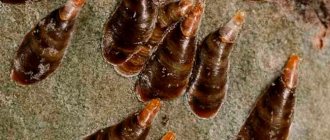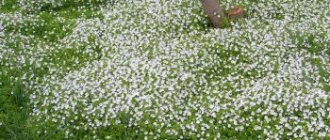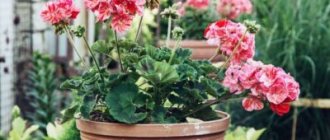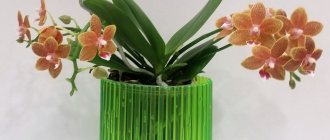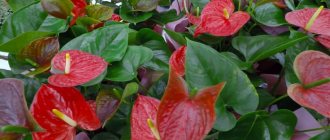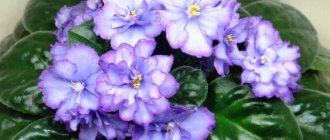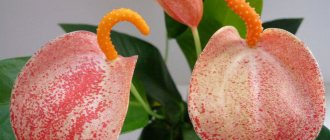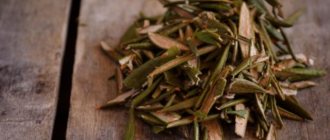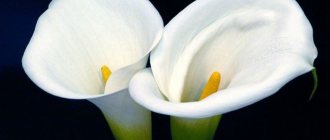Lychnis is a perennial decorative flowering shrub, popularly nicknamed “Adonis” for its bright, rich color. According to another version, the name refers to one of the varieties, the stems of which in ancient times were used as a wick for lamps and icon lamps. The second unofficial name is “soap plant,” given to it for the ability of the petals to become soapy when rubbed with your hands. It has been cultivated since the 16th century; currently, Lychnis is grown in the open ground of garden plots throughout almost the entire territory of Russia. It has many decorative varieties and hydrides.
General description with photo
Lychnis is a shrubby perennial plant from the Clove family, up to 1 m high. The round, erect stem has short pubescence, an unusual ash-gray hue and a very small number of semi-stem-embracing elongated leaves with a heart-shaped base. The leaf blades are rough on both sides. The flowering is bisexual, the inflorescences are spherical or corymbose, collected from many small, up to 2 cm, buds, colored from white or light yellow to bright orange or deep red. Some species produce single buds and do not form inflorescences. By the beginning of autumn, the multi-nut fruit ripens, filled with dark small kidney-shaped seeds that retain their viability for no more than 3-4 years.
Description of a bright plant
Lychnis crownata is a member of the Carnation family. Externally, the flower bears no resemblance to Zorka. It has curved shoots with silvery-gray leaves and crimson flowers. Breeders developed the colors white and pink. The flower is a perennial, but biennials are often found in the middle zone.
The herbaceous plant is not tall, its height ranges from 40 cm to 90 cm. Flowering begins in June, an abundant flowering period occurs in summer, some inflorescences bloom in autumn. The bush has an openwork appearance, and during the summer period it is capable of growing a huge number of branched shoots. Its leaves are covered with a slightly silvery coating. The shape of the leaves on the basal rosette is oblong-lanceolate, and oval on the shoots.
In autumn, the beauty of the plant does not become worse, because the ashy background of the foliage allows individual flowers to light up. Lychnis flowering lasts about a month, but removing dried flowers helps to extend it for a couple of weeks. As mentioned above, the plant has soapiness, namely, the rhizome and petals have this property.
Among the people, the plant also has other names; for example, you can often find it under the name adonis, “soap plant” or Zorka. The name “soap plant” came about for a reason; the flower has incredible soapiness, which is why it was often used as soap in the past. In the cities of our country, only two varieties of flowers are common - chalcedony and crown. But the variety doesn’t end there; on the contrary, the number of different shapes and brightness of the petals is amazing!
Planting and caring for crown lychnis is not particularly difficult, which is why it is recommended to grow it even for beginners in gardening.
Varieties and varieties of Lychnis with photos
Information about the species diversity of this plant is very contradictory; from 2 to 5 dozen varieties are named. Of these, only 15 species are grown in horticulture, suitable for cultivation in open ground conditions of a temperate climate zone.
This perennial can grow in one place for about 5 years.
Lychnis Chalcedonian
Produces an erect, meter-tall stem with short, hard pubescence. The leaves are sparse, located mainly in the lower part. The inflorescence is spherical, consists of many small red flowers (in the basic version).
Lychnis crown
The highly branched stems are silver in color and can also grow to a height of 1 m. A characteristic feature of the species is single flowering - the flowers are not collected in inflorescences and are larger in size. The species is valued for its long flowering, which lasts almost the entire summer. This variety is the most shade-tolerant.
Lychnis alpine
A low-growing representative of the culture, rising only 20 cm from the ground, with excellent decorative qualities. The most popular variety of the variety is “Lara”, which blooms buds in a delicate pink color. When growing this variety in open ground, you need to pay special attention to the acidity of the soil. Like all representatives of the variety, he cannot tolerate its inflated indicators.
Lychnis Viscaria
Tall species with dark purple shoots. It differs from other varieties in the appearance of the inflorescences, which have a paniculate shape and double buds, painted in white, soft pink or crimson tones. Flowering continues throughout the first 2 months of summer.
Lychnis Haage
Forms a medium-sized bush and is a varietal garden hybrid. The inflorescence is racemose, neat, orange or bright red in color. The best representative of the species is the “Scorched Lava” variety with the fiery color of the petals.
Lychnis of Jupiter
The variety is represented by a highly branched, loose bush with silvery-ashy, short pubescent shoots and single flowers of raspberry-purple color.
Plant in landscape design
The plant is used for group plantings; it decorates rocky hills, mixborders and rockeries. The perennial looks good on the banks of decorative ponds.
In the design of flower beds, lychnis can be combined with:
- bells;
- gypsophila;
- carnations;
- chrysanthemums.
A very beautiful plant is used to create bright spots in a flower bed, as the color accents attract the eyes of passers-by. Looks good in a rock garden among yellow flowers.
Lychnis is used for bouquets, although it very quickly loses its attractiveness.
Expert opinion
Yulia Yurievna
I have a large garden and vegetable garden, several greenhouses. I love modern methods of cultivating plants and mulching the soil, and I share my experience.
Ask a Question
You can plant Lychnis crown along a gravel path or path, which is fenced around the perimeter with medium and large stones. Flowers will look harmonious with such decor, as they themselves have a natural appearance. Such an ensemble will remind you of a real path in the mountains or in the forest.
You can place the described flowers among a flower bed in which deciduous plants predominate. In addition, the plant will look good near ornamental grasses.
If the site has a recreation area with a bench or gazebo, you can place bushes with bright flowers around the perimeter. And their unobtrusive aroma will make your vacation even more pleasant.
The described plant does not grow well on swampy soil, therefore, when located near a reservoir, care should be taken to plant it on a small embankment or hill.
If there is a dry stream in the garden, it can also be supplemented with lychnis. As you can see, this is an almost universal plant for a site whose landscape is decorated in a natural style. Although, even in a flower garden with large exotic buds, this plant would be a good option for contrast.
Planting and care
Lychnis does not make high demands on growing conditions, but they still exist. His agricultural technology provides the following care points and conditions for planting in open ground.
Illumination
The culture can easily tolerate partial shading, but the abundance and brightness of flowering will be directly dependent on the sunlight it receives.
Soil requirements
The main requirement of Lychnis for soil, especially some of its varieties, is its acidity. The plant does not tolerate too acidic soils. The situation with high pH can be corrected by adding lime fluff. The second important condition is that the soil must be well drained and light enough. In places of low relief, where melt, rain and irrigation waters stagnate, Lychnis will look depressed and may even die.
Watering mode
The plant loves regular moderate watering without stagnant water. If lychnis is planted on heavy clay soil, it will have to be watered in small portions to avoid prolonged high humidity. In the absence of regular rain, it is enough to moisten the soil once or twice a week.
It is recommended to water lychnis in the morning, since it tends to actively absorb moisture only during sunny hours. Evening watering can lead to useless and even harmful soaking of the roots.
Top dressing
The first application of fertilizers is made at the stage of planting in open ground. The area is dug up with the addition of 50 g of potassium magnesia (potassium-magnesium sulfate) and the same amount of granulated superphosphate per 1 sq.m. to the soil. The next feeding is done before budding begins, adding 1 tbsp to the water for irrigation. into a bucket of potassium sulfate and urea. If superphosphate was not added during planting, then the same amount of this product should be added. If desired, you can feed the bushes one or two more times, using any mineral complexes, for example, the plant responds well to the application of the drug "Agricola 7".
Lychnis care after flowering, pruning
The plant does not require formative pruning, but to preserve its decorative effect, it is necessary to immediately tear off all wilted buds, this will additionally stimulate the formation of new ones. In preparation for the winter season, the entire above-ground part of the plant is completely removed (without roots). It is not recommended to break off the stems to avoid damage to the root system; it is better to cut them off with garden pruners. The crop has high frost resistance, so basic varieties and simple varieties will not need any shelter in winter. But this does not apply to terry garden hybrids, which do not have high natural survival rate in extremely cold winters. After pruning, they must be covered with a thick layer of mulch, for which peat, dry fallen leaves or sawdust are well suited. You can simply heap a high layer of dry soil over the wintering site of the roots.
Lychnis care
Lychnis grown in the garden must be provided with systematic watering, especially if there is intense heat. When the plant is watered, it is necessary to systematically loosen the surface of the soil in the area, while removing all the weeds. Please note that such a flower can easily be drowned out by weeds, and therefore the future of this plant depends only on you. In order for the lychnis to bloom longer, it is necessary to promptly remove the inflorescences that have begun to fade, and at the same time pull out all the plants that are trying to get into the lychnis area.
During the growing season, such a plant should be fed only 2 or 3 times per season. Slightly grown and strengthened seedlings are fed with complex mineral fertilizer. Then similar feedings are carried out once every 15–20 days.
Diseases and pests
If you water such a flower too much or too often, this can cause the development of rust, root rot and leaf spotting. For preventive purposes, it is recommended to develop such a watering schedule, taking into account the weather conditions of your region, so that there is no stagnation of liquid in the root system of the plant. If the first symptoms of the development of a fungal disease are noticed, the affected specimen must be sprayed with a fungicidal preparation.
If leaf rollers or aphids settle on a bush, then to destroy them it is necessary to use a decoction of tomato tops or tobacco, into which you need to add soap crushed with a grater. If there are too many harmful insects, then you can deal with them by treating the bush with an insecticidal agent.
After flowering
For wintering, this flower does not require shelter, as it has a very high resistance to frost. However, if you grow terry varieties of lychnis, then they must be covered for the winter. After the foliage and shoots begin to yellow and wilt, they must be cut back to the ground. Terry bushes, after they are trimmed, should be covered with a layer of leaves, peat or dry soil.
Growing Lychnis from Seeds
One way to propagate a plant is by sowing seeds. Planting material remains viable for at least 3 years, so you can plant lychnis seeds both before winter and in spring, when the snow melts. Pre-winter sowing is more desirable, since in this case they will benefit from natural stratification in the cold soil. At home, stratification for a month is also a mandatory procedure for lychnis. The second advantage of winter growing from seeds is earlier flowering - in this case it can occur as early as the summer of next year, although not in full force. A more troublesome method can speed up the process - sowing seeds using the seedling method, which will also allow you to get flowering already in the current season.
Before transplanting seedlings into open ground, they must be gradually hardened in air for 2 weeks, first during the day and then at night. You can sow seeds directly into open ground from April to June; later planting will not produce healthy plants.
The time period for the emergence of Lychnis seeds is 20-25 days, but they can vary depending on temperature conditions.
Planting scheme
When transferring seedlings to open ground, it is necessary to leave 25-30 cm between the seedlings; this will give a dense flower bed without bald spots, but will eliminate its thickening, which can provoke fungal diseases.
Lychnis crown - general characteristics
This beauty belongs to the large family of biennial plants, Cloveaceae, which came from Southern Europe. The short-lived perennial has silver-gray felt leaves and small spray-like flowers perched on long stems.
With proper care, Lychnis crown provides a colorful display of white, pink, and bright crimson until autumn. Recently, two-color and hybrid ones with terry have appeared. The genus name Lychnis is taken from the Greek lychnos for "lamp", referring to its historical use of leaves as a lamp wick.
Reproduction by dividing the bush
The method is simple and quick in terms of obtaining results, but only lychnis bushes that are at least 5 years old are suitable for it, i.e. those that, due to age, are already losing their decorative effect and need to be updated. In October or early spring, the bush is dug up with maximum coverage of the root system, carefully cleared of the main soil and divided into several parts. The number of divisions is determined based on the development of the rhizome. Each of them must retain its viable part and at least one growth point. The resulting bushes are planted immediately in a permanent place, maintaining the above distance. Abundant watering is carried out.
If the bush was transplanted in the spring, it is necessary to ensure that in the first days after this the seedlings are shaded from the too active spring sun.
Propagation by cuttings
This method of propagating Lychnis is most preferable for terry varietal hybrids. The seed method is acceptable for them only if you purchase ready-made seeds from the manufacturer, since seeds collected at home will not be able to obtain the same decorative qualities. As for dividing the bush, only well-developed, middle-aged plants are suitable for it. Cuttings are cut in June. Due to the rare location of the stem buds, their length should be at least 20-25 cm in order to guarantee that they capture the growing points. Rooting occurs according to the traditional pattern in a box or on a training bed with nutritious loose soil under a plastic or glass cap. Transplantation to a permanent place can be carried out in early autumn, so that by winter the cuttings have time to acclimatize and take root well. In the first winter it is better to cover them.
What does the plant look like?
The Lychnis crown flower is a perennial plant, but in most Russian regions it is grown as a biennial crop. The variety can grow up to 1 meter in height, the bush is lush and branches well. It has medium-sized, oval-shaped leaves of an unusual silver-green color. The same spectacular silver coating is also inherent in the stems of the plant. Lychnis shoots are curved and branch throughout the summer. All of them are strewn with buds of white or crimson, less often burgundy or red, which “burn” with a silvery tint; it is because of this feature that the culture is called adonis. The flowers are round in shape, each with five petals.
Comment! Recently, breeders have developed a new variety of crown lychnis, which has two-color buds.
The leathery adonis blooms profusely and continuously. The first buds appear in June, and the last ones fall only in November.
Diseases and pests
The main lovers of Lychnis among insect pests are the moth, leaf roller and the ubiquitous aphid. You can fight minor lesions with folk remedies - tobacco, garlic and soap solutions. In case of advanced attacks, chemical agents cannot be avoided. In the event of an aphid invasion, it is necessary to take control measures against their main distributors - ants.
Lychnis diseases are almost always the result of improper care, in most cases - dense planting or waterlogged soil. It is necessary to establish the cause and eliminate it. Plants affected by putrefactive processes will have to be removed from the site and burned.
Lichnes crown - use in the garden
Lichnes looks very attractive in flower beds in the background. In the foreground I always plant daisies, variegated euonymus, then bluebells, primrose, sedum, cornflowers and naive.
You can make a mix of only one lichnes with different colors. Lichnes also takes root well in village plots and decorates garden corners. An unpretentious but charming lychnis will take root wonderfully in any garden and will delight you with its blazing candles for a long time.

